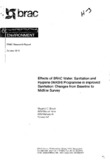| dc.contributor.author | Ghosh, Shyamal C | |
| dc.contributor.author | Rana, AKM Masud | |
| dc.contributor.author | Ali, ARM Mehrab | |
| dc.contributor.author | Arif, Tahmid | |
| dc.date.accessioned | 2019-12-01T06:34:43Z | |
| dc.date.available | 2019-12-01T06:34:43Z | |
| dc.date.issued | 2010-10 | |
| dc.identifier.citation | Ghosh, S. C., Rana, A. M., Ali, A. M., & Arif, T. (2010, October). Effects of BRAC Water, Sanitation and Hygiene (WASH) Programme in improved sanitation: changes from baseline to midline survey. Research Reports (2010): Health Studies, Vol - XLII, 35–58. | en_US |
| dc.identifier.uri | http://hdl.handle.net/10361/13157 | |
| dc.description.abstract | To facilitate achieving national target of 1 00 percent sanitation in Bangladesh by the year 2013,
BRAC Water. Sanitation and Hygiene (WASH) programme has been working in 150 upazilas for
improving water supply, sanitation and hygiene practices. This study investigated the effect of BRAC
WASH programme on sanitation in the intervention areas after two years of implementation, by
comparing the data of baseline and midline surveys. Data of 30,000 households from 50 upazilas
were used to measure the improvement in sanitation at household level. The sanitation situation in
the same upazilas at institutional level was studied by surveying educational institutions (2 ,395 during
baseline and 1,487 during midline), which were financed by the BRAC WASH programme for
arranging improved sanitation facilities. Use of sanitary latrines increased significantly (p<0.001) both
at household (7.1 %) and institutional level (2.4%). Additionally, the quality of sanitary latrines
improved significantly (p<0.001 ). During midline survey higher percentage of latrines were found
clean (17.2% at the households, 23.7% at the educational institutes) and with available water nearby
the latrines (5.5% at the households, 11.4% at the institutes). There were also reduced percentage
of latrines with stink (14 .8% at the households. 22.4% at the institutes) and residual fecal left (12 .8%
at the households, 21 .6% at the institutes). The improvements of sanitation status could be
attributed to the BRAC WASH activities implemented in the study areas for 2 years. However, there
were some impediments revealed from the study, i.e., shifting of households using sanitary latrines to
unsanitary practices, poverty, illiteracy etc .. which were slowing down the sanitation improvements.
Thus, the BRAC WASH programme needs strengthening of ongoing activities addressing the key
impediments at household level together with extended support for educational institutions to
achieve the set goals. | en_US |
| dc.language.iso | en | en_US |
| dc.publisher | BRAC Research and Evaluation Division (RED) | en_US |
| dc.subject | BRAC | en_US |
| dc.subject | WASH Programme | en_US |
| dc.subject.lcsh | Rural health services--Bangladesh. | |
| dc.subject.lcsh | Health, Nutrition, and Population Program (BRAC) | |
| dc.subject.lcsh | Sanitation. | |
| dc.subject.lcsh | Water-supply -- Health aspects. | |
| dc.subject.lcsh | Public health. | |
| dc.title | Effects of BRAC Water, Sanitation and Hygiene (WASH) Programme in improved sanitation: changes from baseline to midline survey | en_US |
| dc.type | Research report | en_US |

